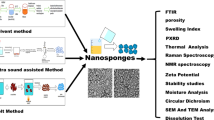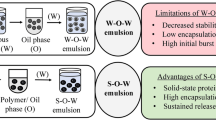Abstract
Purpose
To investigate the use of Carbopol® 974P as a stabilizing agent for supersaturated levels of itraconazole (ITZ) in neutral pH aqueous media and the resultant effects on oral absorption of ITZ.
Methods
Carbopol® 974P was incorporated into an EUDRAGIT® L 100-55 carrier matrix at concentrations of 20% and 40% based on polymer weight with the aim of prolonging supersaturated ITZ release from the enteric matrix. Amorphous solid dispersions of ITZ in EUDRAGIT® L 100-55 containing either 20% or 40% Carbopol® 974P were produced by hot-melt extrusion (HME). Solid state analysis of these compositions was performed using differential scanning calorimetry and qualitative energy dispersive X-ray spectroscopy. Dissolution analysis was conducted using a pH change method. Oral absorption of ITZ was evaluated in male Sprague–Dawley rats.
Results
Solid state analysis demonstrated that the extruded compositions were entirely amorphous and homogenous with respect to drug distribution in the polymer matrix. Dissolution analysis revealed that the addition of Carbopol® 974P to the EUDRAGIT® L 100-55 carrier system functioned to prolong the release of supersaturated levels of ITZ from the EUDRAGIT® L 100-55 matrix following an acidic-to-neutral pH transition. In vivo evaluation of ITZ absorption revealed that the addition of Carbopol® 974P substantially reduced the absorption variability seen with the EUDRAGIT® L 100-55 carrier system. In addition, the 20% Carbopol® 974P formulation exhibited a five-fold improvement in absorption over our initially reported ITZ particulate dispersion compositions that limited supersaturation of ITZ primarily to the stomach.
Conclusions
The results of this study strongly suggest that substantial improvements in oral antifungal therapy with ITZ can be achieved via intestinal targeting and polymeric stabilization of supersaturation.





Similar content being viewed by others
References
D. A. Miller, J. T. McConville, W. Yang, R. O. Williams III, and J. W. McGinity. Hot-melt extrusion for enhanced delivery of drug particles. J. Pharm. Sci 96(2):361–376 (2007).
D. A. Miller, J. C. DiNunzio, W. Yang, J. W. McGinity, and R. O. Williams III. Enhanced In vivo Absorption of Itraconazole via Stabilization of Supersaturation Following Acidic-to-Neutral pH Transition Drug Development and Industrial Pharmacy 2007;(in press) DOI 10.1080/03639040801929273.
W. S. Snyder, M. J. Cook, E. S. Nasset, L. R. Karhausen, G. P. Howells, and I. H. Tipton. Report of the Task Group on Reference Man. Pergamon Press, New York, 1975.
J. M. DeSesso, and C. F. Jacobson. Anatomical and physiological parameters affecting gastrointestinal absorption in humans and rats. Food Chem. Toxicol 39(3):209–228 (2001).
M. Mayersohn. Principles of Drug Absorption. In G. S. Banker, and C. T. Rhodes (eds.), Modern Pharmaceutics, Marcel Dekker, New York, 1996, pp. 21–74.
D. A. Miller, J. W. McGinity, and R. O. Williams III. Solid dispersion technologies. In R. O. Williams III, D. R. Taft, and J. T. McConville (eds.), Advanced Drug Formulation Design to Optimize Therapeutic Outcomes, Informa Healthcare USA, New York, NY, USA, 2007, pp. 451–491.
P. Gao, M. E. Guyton, T. Huang, J. M. Bauer, K. J. Stefanski, and Q. Lu. Enhanced oral bioavailability of a poorly water soluble drug PNU-91325 by supersaturatable formulations. Drug Dev. Ind. Pharm 30(2):221–229 (2004).
P. Gao, and W. Morozowich. Development of supersaturatable self-emulsifying drug delivery system formulations for improving the oral absorption of poorly soluble drugs. Expert Opinion on Drug Delivery 3(1):97–110 (2006).
R. Vandecruys, J. Peeters, G. Verreck, and M. E. Brewster. Use of a screening method to determine excipients which optimize the extent and stability of supersaturated drug solutions and application of this system to solid formulation design. Int. J. Pharm 342(1–2):168–175 (2007).
M. E. Brewster, and T. Loftsson. Cyclodextrins as pharmaceutical solubilizers. Adv. Drug Deliv. Rev 59(7):645–666 (2007).
N. Kondo, T. Iwao, K. Hirai, M. Fukuda, K. Yamanouchi, K. Yokoyama, M. Miyaji, Y. Ishihara, and K. Kon. Improved Oral Absorption of Enteric Coprecipitates of a Poorly Soluble Drug. J. Pharm. Sci 83(4):566–570 (1994).
N. Kohri, Y. Yamayoshi, H. Xin, K. Iseki, N. Sato, S. Todo, and K. Miyazaki. Improving the oral bioavailability of albendazole in rabbits by the solid dispersion technique. J. Pharm. Pharmacol 51(2):159–164 (1999).
N. Kohri, Y. Yamayoshi, K. Iseki, N. Sato, S. Todo, and K. Miyazaki. Effect of gastric pH on the bioavailability of albendazole. Pharm. Pharmacol. Commun 4:267–270 (1998).
Carbopol® 974P NF Polymer—Product Specification. 2007 (accessed August 2007, at www.lubrizol.com.).
D. A. Miller, M. Gamba, D. Sauer, T. P. Purvis, N. T. Clemens, and R. O. Williams III. Evaluation of the USP dissolution test method A for enteric-coated articles by planar laser-induced fluorescence. Int. J. Pharm 330(1–2):61–72 (2007).
J. Peeters, P. Neeskens, J. P. Tollenaere, P. Van Remoortere, and M. Brewster. Characterization of the interaction of 2-hydroxypropyl-B-cyclodextrin with itraconazole at pH 2, 4 and 7. J. Pharm. Sci 91:1414–1422 (2002).
P. O. Gubbins, B. J. Gurley, and J. Bowman. Rapid and sensitive high performance liquid chromatographic method for the determination of itraconazole and its hydroxy-metabolite in human serum. J. Pharm. Biomed. Anal 16:1005–1012 (1998).
J. M. Vaughn, J. T. McConville, D. Burgess, J. I. Peters, K. P. Johnston, R. L. Talbert, and R. O. Williams Iii. Single dose and multiple dose studies of itraconazole nanoparticles. Eur. J. Pharm. Biopharm 63(2):95–102 (2006).
K. A. Overhoff, A. Moreno, D. A. Miller, K. P. Johnston, and R. O. Williams Iii. Solid dispersions of itraconazole and enteric polymers made by ultra-rapid freezing. Int. J. Pharm 336(1):122–132 (2007).
K. Six, C. Leuner, J. Dressman, G. Verreck, J. Peeters, N. Blaton, P. Augustijns, R. Kinget, and G. Van den Mooter. Thermal Properties of Hot-Stage Extrudates of Itraconazole and Eudragit E100. Phase separation and polymorphism. J. Therm. Anal. Calorim 68(2):591–601 (2002).
K. Six, J. Murphy, I. Weuts, D. Q. M. Craig, G. Verreck, J. Peeters, M. Brewster, and G. Van den Mooter. Identification of Phase Separation in Solid Dispersions of Itraconazole and Eudragit® E100 Using Microthermal Analysis. Pharm. Res 20(1):135–138 (2003).
K. Six, G. Verreck, J. Peeters, M. E. Brewster, and G. Van den Mooter. Increased physical stability and improved dissolution properties of itraconazole, a class II drug, by solid dispersions that combine fast- and slow-dissolving polymers. J. Pharm. Sci 93(1):124–131 (2004).
G. van den Mooter, G. Verreck, M. Brewster, J. Peeters, I. Weuts, A. DeCorte, K. Heymans, D. Kempen. inventors; Janssen Pharmaceutica N.V., assignee. Solid Dispersions of a Basic Drug Compound and a Polymer Containing Acidic Groups patent WO/2005/117834. 2005.
K. Six, G. Verreck, J. Peeters, K. Binnemans, H. Berghmans, P. Augustijns, R. Kinget, and G. Van den Mooter. Investigation of thermal properties of glassy itraconazole: identification of a monotropic mesophase. Thermochimica Acta 376(2):175–181 (2001).
L. Huang, and J. Schwartz. Studies on drug release from a carbomer tablet matrix. Drug Dev. Ind. Pharm 21(13):1487–501 (1995).
V. R. Goskonda, I. K. Reddy, M. J. Durrani, W. Wilber, and M. A. Khan. Solid-state stability assessment of controlled release tablets containing Carbopol(R) 971P. J. Control. Release 54(1):87–93 (1998).
M. M. Meshali, G. M. El-Sayed, Y. El-Said, and H. M. El-Aleem. Preparation and evaluation of theophylline sustained release tablets. Drug Dev. Ind. Pharm 22:373–376 (1996).
B. Perez-Marcos, J. L. Ford, D. J. Armstrong, P. N. Elliott, and J. E. Hogan. Release of propranolol hydrochloride from matrix tablets containing hydroxypropyl methyl cellulose K4M and Carbopol 974. Int. J. Pharm 111:251–259 (1994).
S. Neau, M. Chow, and M. J. Durrani. Fabrication and characterization of extruded and spheronized beads containing Carbopol 974P NF resin. Int. J. Pharm 131:47–55 (1996).
T. C. Hardin, J. R. Graybill, R. Fetchick, R. Woestenborghs, M. G. Rinaldi, and J. G. Kuhn. Pharmacokinetics of itraconazole following oral administration to normal volunteers. Antimicrob. Agents Chemother. 32(9):1310–1313 (1988).
S. Lee, K. Nam, M. S. Kim, S. W. Jun, J. S. Park, J. S. Woo, and S. J. Hwang. Preparation and characterization of solid dispersions of itraconazole by using aerosol solvent extraction system for improvement in drug solubility and bioavailability. Arch. Pharm. Res. 28(7):866–874 (2005).
A. J. Ribeiro, R. J. Neufeld, P. Arnaud, and J. C. Chaumeil. Microencapsulation of lipophilic drugs in chitosan-coated alginate microspheres. Int. J. Pharm 187(1):115–123 (1999).
A. Fahr, P. V. Hoogevest, S. May, N. Bergstrand, and M. L. S. Leigh. Transfer of lipophilic drugs between liposomal membranes and biological interfaces: Consequences for drug delivery. Eur. J. Pharm. Sci 26(3–4):251–265 (2005).
K. Moser, K. Kriwet, C. Froehlich, Y. N. Kalia, and R. H. Guy. Supersaturation: Enhancement of Skin Penetration and Permeation of a Lipophilic Drug. Pharm. Res 18:1006–1011 (2001).
H. Takeuchi, H. Yamamoto, and Y. Kawashima. Mucoadhesive nanoparticulate systems for peptide drug delivery. Adv. Drug Deliv. Rev. 47(1):39–54 (2001).
A. Singla, M. Chawla, and A. Singh. Potential applications of carbomer in oral mucoadhesive controlled drug delivery system: a review. Drug Dev. Ind. Pharm. 26:913–924 (2000).
J. Llabot, R. Manzo, and D. Allemandi. Drug release from carbomer:carbomer sodium salt matrices with potential use as mucoadhesive drug delivery system. Int. J. Pharm 276:59–66 (2004).
K. P. R. Chowdary, and Y. S. Rao. Design and In vitro and In vivo Evaluation of Mucoadhesive Microcap-sules of Glipizide for Oral Controlled Release: A Technical Note. AAPS PharmSciTech 4(3):1–6 (2003).
G. Borchard, H. L. Lueen, A. G. de Boer, J. C. Verhoef, C.-M. Lehr, and H. E. Junginger. The potential of mucoadhesive polymers in enhancing intestinal peptide drug absorption. III: Effects of chitosan-glutamate and carbomer on epithelial tight junctions in vitro. J. Control. Release 39(2–3):131–138 (1996).
A. Bernkop-Schnurch, B. Gilge. Anionic Mucoadhesive Polymers as Auxiliary Agents for the Peroral Administration of (Poly)Peptide Drugs: Influence of the Gastric Juice. In: Informa Healthcare, 2000, pp. 107–113.
N. Thirawong, J. Nunthanid, S. Puttipipatkhachorn, and P. Sriamornsak. Mucoadhesive properties of various pectins on gastrointestinal mucosa: An in vitro evaluation using texture analyzer. Eur. J. Pharm. Biopharm 67(1):132–140 (2007).
S. S. Davis. Formulation strategies for absorption windows. Drug Discov. Today 10(4):249–257 (2005).
A. Bernkop-Schnurch, and A. Greimel. Thiomers: The next generation of mucoadhesive polymers. American Journal of Drug Delivery 3(3):141–154 (2005).
N. A. Peppas, and Y. Huang. Nanoscale technology of mucoadhesive interactions. Adv. Drug Deliv. Rev 56(11):1675–1687 (2004).
Acknowledgements
The authors would like to thank Dr. J. P. Zhou for his assistance with TEM Imaging.
Author information
Authors and Affiliations
Corresponding author
Rights and permissions
About this article
Cite this article
Miller, D.A., DiNunzio, J.C., Yang, W. et al. Targeted Intestinal Delivery of Supersaturated Itraconazole for Improved Oral Absorption. Pharm Res 25, 1450–1459 (2008). https://doi.org/10.1007/s11095-008-9543-1
Received:
Accepted:
Published:
Issue Date:
DOI: https://doi.org/10.1007/s11095-008-9543-1




